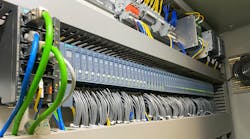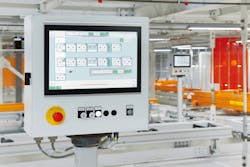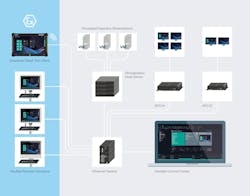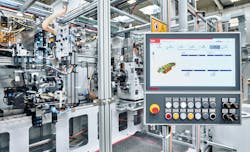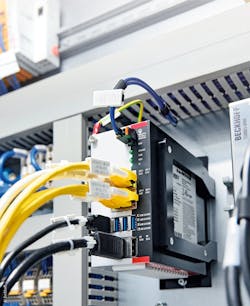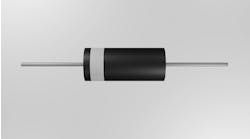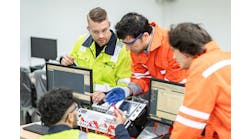A Control Design reader writes: I keep hearing about the great upsides of PC-based control platforms: lower cost and smaller footprint. Free product support is another upside, and the scan times are fractions of what a legacy programmable logic controller (PLC) or programmable automation controller (PAC) takes.
On the downside are the potential phase-outs of hardware and software that leave applications unsupported. A PLC’s useful life is around 10 years, but industrial PCs are obsolete within three years. Operating systems and hardware platforms are locked in step, and I’ve heard nightmares about the 32-bit/64-bit situation, as well as horror stories resulting from the retirement of Windows XP.
Are the advantages of PC-based control worth the potential risks?
Answers
Incorporate components that are available long-term
I believe that there is no right or wrong when distinguishing between traditional PLCs and PC-based control systems. Both have their pros and cons, and the choice of the right avenue might vary with the application and preference or direction of expertise.
While I do not want to comment too much on PLCs, as those seem to be a well-known architecture, I want to comment on the few points regarding the PCs—industrial PCs, to be precise.
When looking at commercial-grade personal computers, the statement about short product life is probably valid. Good industrial computers incorporate different components to ensure machine builders a long availability (Figure 1). The main processor—as the most critical component—should be, therefore, from Intel’s long-term Embedded Roadmap, meaning that it is available somewhere between 7 to 15 years from its launch. Machine builders should consider buying an industrial computer that incorporates long-term available components and choose from new product families to benefit from the longest possible product life.
Similar is the topic with operating system. Industrial computers are often offered with long-term available operating-system distributions. While Windows 7, for instance, was taken off the market for the consumer and commercial market years ago, it is just phasing out for the industrial world now.
In terms of footprint/size comparison of a traditional PLC and an industrial PC, it probably depends on the application and the choice of hardware. I assume that the footprint can be in favor of each, depending on the platform and configuration. There are devices with particularly small footprints for both PLCs and for industrial computers.
What should be kept in mind are the benefits that come with each platform.
• Do I need hard real-time performance? A PLC might be the more solid choice, even though there are real-time-capable soft PLCs on the market.
• Do I need to store larger amounts of data locally? This is a clear benefit of an industrial computer, where storage space is easily scalable.
• Do I need an integrated human-machine-interface (HMI) screen? This is also a benefit for an industrial computer, where the machine builder can minimize the number of devices.
For product support, this is not a platform-specific question, in my opinion. There are manufacturers for both PLCs and industrial computers that charge for any kind of service or offer free service. This is rather a choice of the right partner—trusted vendor of industrial components. What is a true statement is that several components in an industrial computer are easily accessible and therefore serviceable or scalable, locally by machine builders or their customers.
Bernd Mathias / operational manager—industrial PCs/ Phoenix Contact
Thin-client architecture extends useful lifecycle
It honestly will depend on the specific application and the customer installation, but certainly there are benefits to using a PC-based control architecture that may outweigh any potential risks.
Windows versions will become obsolete over time; there is no question about that, but Microsoft does offer Enterprise long-term-servicing-channel (LTSC) versions, which have elongated support and patch releases along with other tools and features specifically for industrial customers. These versions can help ease the burden of software compatibly and extend the life of the used software platform.
PCs also tend to be a much more open architecture, which would allow for a variety of different software and hardware to be used depending on the application requirements. This is going to allow the user to be much more flexible in terms of designing and implementing the control system, especially if there are situations where the equipment must be located within industrial and/or hazardous classified areas.
Cost and scalability are also a topic that could be in favor of a PC-based solution. PCs will be easier to scale than a PLC-based application, as they can easily be updated to handle more data processing by simply adding more memory or processing power. Scaling a PLC in the same way is not always possible and could lead to additional costs and complexity.
An additional layer on top of the PC argumentation would be to implement a thin-client architecture as opposed to running full PCs. The thin clients would be connected back to the main server—virtualized or physical—via some type of network protocol, such as Microsoft Remote Desktop Protocol (RDP) or a virtual network computing (VNC) software, and allow for lower-cost hardware to be used within the industrial areas (Figure 2). Thin clients will ultimately have a longer useful lifecycle than traditional PCs due to their nature of design/usage and can save additional costs on installation, qualification and replacement over the course of five, 10 or 15 years.
Aaron Severa / product manager—HMI, FieldConnex, remote IO / Pepperl+Fuchs
Application-agnostic PCs embrace evolution more quickly
I suppose the answer here might depend on how quickly your company wants to be able to innovate. It’s true that technologies, libraries, operating systems, protocols and everything else tend to move on more quickly toward obsolescence in the PC world than in the PLC world. But, to take another angle on this, those same factors moving more quickly in PC solutions also allow you to more readily embrace the rapid iterations and innovations that come along. Technology advancements are not done just for the fun of it.
There are deliberate motivations behind these changes. Each improvement is done with the intention of allowing users to do more, to do it on a greater scale and to do it with more efficiency. The same forces are applied in both PLCs and PCs, as, underneath it all, these share many commonalities. However, the fact that PCs are designed to be more application-agnostic and less hardware-oriented allows for evolution to take place more quickly.
Regardless of whether you take a stance that is more PLC or PC-centric, an important factor to consider is what dependencies your application has: is there a path forward, and does the vendor have a future-proof plan? The horror stories resulting from Windows XP’s retirement weren’t a result of the need for us to start building systems with a newer operating system.
These resulted from the plethora of software technology providers who had made no forward-looking plans for what comes next. No technology is going to be relevant forever. All will eventually face obsolescence. The key goal is to pick technology providers who have a vision and a plan for how to stay ahead of the curve and who can help carry you forward along the way.
Jotham Kildea / solutions sales engineering supervisor / Iconics
Reduce the risk of choosing the wrong control architecture
The breadth of applications for PC- and PLC-based control is increasing, and the line between PLC and PC is becoming more nebulous. Driven by the production pressures to reduce costs within manufacturing, increase finished goods part counts and establish a robust log of traceability data to clearly document quality, both PC- and PLC-based control architecture have their merits, many of which you have clearly articulated. The risks of choosing the wrong control architecture can be devastating, and you are absolutely correct in taking an objective perspective when comparing the two control-based architectures. Before we address the risks of PC-based control, two pieces of data should be gathered, the first being the prioritization of the facilities’ objectives; the second are principles to compare each architecture’s specifications to these objectives.
Each of the facilities’ objectives, not only from the perspective of one department, but the facility as whole, should be paired with the facilities’ pressures, which are incentivizing the achievement of the objectives, as well as the facilities’ current challenges inhibiting the objectives from coming to reality immediately. This prioritization will help when guiding the selection between PC- and PLC-based control architectures and even between different PC and PLC manufacturers.
You are absolutely correct that phase-outs can become a source of risk. Moore’s Law does limit the product lifecycle of specific PC models, and software development is continuing at an ever-increasing pace. When helping customers determine between PC- and PLC-based control, our team builds a rubric, focusing on machine performance, developing transparent and simple architecture and leaving future opportunities to easily harvest more data from the system.
Overlaying these three principles with the facilities’ objectives can help focus the team on not only the obvious costs, such as hardware and software licensing, but also the hidden cost, such as first-pass yield or the opportunity cost of not pursuing other projects and training. Many vendors offer both PLC and IPC platforms for control as both have distinct value when helping facilities meet their production objectives. However, both control methodologies maximize machine performance, minimize architecture complexity without compromising robustness and allow for more data harvesting without incurring additional costs.
For the specific application, the value of a PC-based control system may be worth the risk, but it may not. Laying out your team’s needs and future roadmap can offer both PC and PLC control the opportunity to create a solution, which not only generates returns, but also leaves the door open for sustaining that performance in change that is yet to come.
Thomas Kuckhoff / product manager—controller / Omron Automation Americas
Advantages and disadvantages of PLCs and IPCs
To begin, an important difference between an industrial PC and a PLC is the way it executes a program. A PLC is usually a scan-based program, whereas an IPC is event-driven. More businesses are wanting to make their operations more flexible and scalable, and PC-based control provides such capabilities. Understanding end users’ needs and desire for continued growth and sustainability is vital to helping them select the right solution. Both PLCs and PC-based hardware have their place in modern facilities. You can combine them together to get the best of both worlds or look into PACs.
PLC advantages:
• It’s made for reliable operation in very harsh environments.
• Ease of programming and troubleshooting usually follows scan-based programmable software. See International Electrotechnical Commission (IEC) 61131-3 standard.
• Proprietary processors and unique operating systems are resistant to viruses and cyberattacks.
• It supports scalability with easy-to-add expansion modules and long lifecycles of 15 to 20 years.
• It is used in nearly every industry.
PLC disadvantages:
• I/O options are limited since they’re tied into the same manufacturer.
• It can be expensive.
IPC advantages:
• New industrial PCs are even more resistant to harsh environments and extreme temperatures.
• It has enhanced programming capabilities and increased connectivity and investment value.
• It uses more widely known programming languages, such as C++, and is not tied to one hardware platform.
• It has communication between programmed controls and equipment.
• An IPC can control multiple functions on one platform and runs programs and applications that PLCs cannot.
IPC disadvantages:
• They are difficult to upgrade when new Windows versions are released.
• Long-term product support is lacking.
• They are susceptible to hacking.
Gary Guess / product portfolio manager / RS
Built-in capabilities
Programmable logic controllers and PCs can be used to automate specific functions of machines, entire processes or even entire production lines. These processes can include timing, control, sequencing and starting and stopping motors, pumps and valves. The primary thing that sets PLC control apart from PC-based control is built-in or snap-on input/output (I/O). Many types of I/O can be combined in a PLC: analog, digital, thermocouple. While PC control systems have the same types of I/O available, the I/O is often distributed on a deterministic network.
Programmable logic controllers often need to be connected to other systems, typically PC-based, to complete tasks such as supervisory-control-and-data-acquisition (SCADA) and structured-query-language (SQL) database management. Often PC-based controls have these software features and network capabilities built-in.
Since IPCs use the same hardware and software as hundreds of millions of other PCs across the world, there are no shortages of new updates, products and technology to use. Industrial PCs are widely available, versatile and easy to implement into a system. When the hardware and software used in a system are so mainstream, it’s guaranteed that users will always have state-of-the-art computing power at their fingertips. Industrial PCs often mimic a standard office PC in function, making them familiar to operate and maintain.
Industrial PCs may use Microsoft OS, Linux OS and other operating systems to control non-real-time tasks, which means IPCs can be used for multiple tasks beyond the cyclic control tasks. Additionally, IPCs can combine real-time operating systems with non-real-time operating systems. A real-time operating system is a computing environment that reacts to input within a deterministic time period. A real-time clock and turnaround reaction time can often be measured in microseconds. Industrial PCs also have easy connection to the network using Ethernet connectivity.
Industrial PCs are not a niche market. The cost to purchase and maintain these types of control systems are typically lower for a given processing speed or update rate. Industrial PCs also come in a wide range of sizes and power and can be purchased with options that include fanless or high IP ratings, such as IP67 or higher. Maintenance and replacement may be significantly easier and options to upgrade abound. Often, IPCs from one manufacturer can be replaced with an IPC from another. When processing or computing power becomes a limiting factor, there are usually options to upgrade the processor speed, memory, port options or number of network interface cards.
Industrial PCs have the capability to work with all controllers, including PLCs, and networks such as EtherCAT, Ethernet/IP and Modbus TCP/IP. This allows for a more streamlined, purpose-built control architecture that is flexible and scalable.
Danny Weiss / senior product manager / Newark
The line between PC-based controllers and PLCs is blurred
I’m still a fan of traditional PLCs due to their longevity, long lifecycles and ruggedness. But many PLCs are, at their core, PC-based controllers, as they run a logic engine on a form of Linux or Windows IoT and offer many of the advantages typically associated with PCs, so the line between PC-based controllers and PLCs is becoming blurred.
However, a full-fledged PC can bring many advantages due to its sheer computing power. Industrial Internet of Things (IIoT) integration, databasing and higher-level languages are all very desirable in automation applications, and these are very achievable with PC-based controllers.
Take these precautions to mitigate some of the risks:
• Be sure to use an IPC rather than a standard PC in a cabinet. The ruggedness of the construction will result in a much longer lifespan.
• Be sure to work with a reputable manufacturer and discuss the expected lifespan and opportunities to extend the lifespan. I have worked with more than one company that manufactures IPCs, and they usually offer operating-system upgrades that can extend the useful lifespan of the hardware.
• When selecting a logic engine to run the control, consider a product that is hardware-independent and can be moved around. CoDeSys is a good example of a logic engine that runs on a vast array of operating systems and hardware platforms.
In conclusion, PC-based controllers offer a lot of value and should be considered; just do your homework and contingency planning.
Ted Thayer / principal product marketing specialist—control / Phoenix Contact
PC-based control supports Industry 4.0
First off, you’re right. PC-based control offers undeniable advantages compared to the legacy PLC approach. Industrial PCs (IPCs) offer an unbeatable price-to-performance ratio, and their scan times are incredibly fast (Figure 3).
Beyond that, PC-based control inherently supports the advanced functionality and communication needed to implement Industry 4.0 concepts. All these gains come with reduced hardware cost and footprint. A single IPC can incorporate the functionality of previously separate “black box” CPUs for motion control, safety, machine vision or robotic kinematics. And you can run advanced software—everything from analytics and machine learning to mechatronic transport systems and algorithms written with advanced model-based design toolboxes from MATLAB/Simulink—on one IPC along with the machine control logic.
It's also far easier to scale a PC-based platform. The ability to use modern version/source control via Git, GitHub or team foundation server (TFS) is another bonus. This allows programmers to maintain their code and collaborate between multiple programmers, while also drawing on a broad library of already developed options and examples. However, true support should go beyond that, and only some vendors offer free 24/7 support.
On a basic level that’s really the answer to the concerns about PC-based control: You have to closely evaluate the vendor and understand what they’re offering. An additional thought is that many of these past concerns are already resolved.
This is where you need to know your vendor and how they approach hardware and software. On the hardware side, some PC-based controllers provide a lifecycle of 10 years, plus another 10 years of service. And the vendor absolutely should guarantee, without conditions, that their IPCs and accompanying software can easily migrate to the next-generation CPU. Which, by the way, is not often guaranteed with PLC platforms, leading to total rip-and-replace scenarios of the controller, specialized I/O and more.
On the operating system side, look for options that can separate the PC-based control platform and OS. These don’t have to be “locked in step” necessarily. That is, you shouldn’t have to worry that Microsoft will make your machine control platform obsolete due to hardware upgrade restrictions. PC-based control means using standard PC CPUs and architecture for machine control, but this could mean many different operating systems.
With Windows, Microsoft sets the timeline and supported underlying hardware. Generally, vendors that have a long-term servicing channel (LTSC) with Microsoft can deliver the OS version, such as Windows 10, for a minimum 10-year lifespan. Windows works for many applications, and it will be offered by PC-based controls vendors far into the future. But it’s not the only choice.
Alternative operating systems, such as TwinCAT/BSD based on FreeBSD, provide an opportunity for PC-based control manufacturers to have control over the supported operating system lifecycle on their hardware. FreeBSD is a Unix-compatible open-source operating system directly originating from Berkeley Software Distribution (BSD). These Unix-like options, including TwinCAT/BSD, offer several benefits, including enhanced system security and reduced image size, while still offering the flexibility to implement a hypervisor to run virtualized Windows or Linux when specific software is needed on those platforms. This opens up new possibilities and advantages for users seeking flexible and robust solutions for their PC-based control requirements.
In regards to the 32-bit/64-bit situation, that has been resolved for over a decade. Around 2010, applications and operating systems had outgrown the 32-bit memory space and were migrating to 64-bit. This global transition included industrial controls—PLCs, PACs, IPCs and their engineering tools and runtimes (although lagging PLC vendors only supported 64-bit data types in the past couple of years). It also impacted user applications such as Microsoft Office and millions of others. The entire software and PC industry made the migration. From our perspective, that risk was mitigated long ago.
Despite the broad industry adoption and countless successes of PC-based control, the perception of “potential risks” lingers. Meanwhile, the PLC comfort zone faces some existential threats. Companies putting all their eggs in one basket will continue to have difficulty recruiting young engineering talent. New graduates, even from programs focused on controls and automation, are incredibly skilled in computer science technologies. And they’re excited about these new STEM opportunities and modern controllers and programming languages, rather than struggling to get a dozen different black boxes to slowly execute in quasi-synchronized processes.
PC-based control creates a vast field of possibilities. There are plenty of considerations when comparing vendors, sure. But that’s no reason to take a wait-and-see approach for the next decade to find there’s no skilled labor left to complete your machine designs and programming on a slow, overpriced legacy platform. So we don’t see it as asking you to make a supposedly “risky” investment in PC-based control. We’re asking you to invest in your company’s future.
Eric Reiner / IPC product manager / Beckhoff Automation
PLC and IPC together
As the industrial PC (IPC) market continues to evolve, we are increasingly asked to compare the merits of automation controllers using IPC technology in contrast to classic PLC technology. Today, we are excited to be able to offer both options for different use cases for our customers. While modern IPC technology offers considerable performance, it might not be as effective in extreme environments or increasingly common use cases such as advanced safety, batching, process applications or extended longevity. We believe a holistic approach of leveraging both classic PLC technology and IPC technology provide the most effective options for the vast range of applications in which automation controllers are used in across the industry.
Nisha Chandrasekharan / business manager / Rockwell Automation
